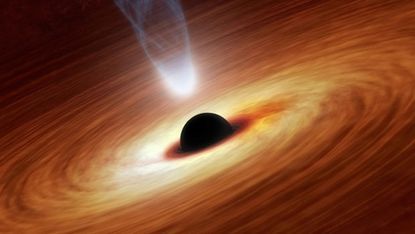Scientists discover new variety of black hole
Astronomers had previously missed entire class of dead star

Scientists have discovered a new type of black hole that is smaller than previously thought possible.
Astronomers from Ohio State University found a black hole that was just 3.3 times the mass of the Sun, a lot smaller than regular black holes, which are typically between five and 15 times the mass of the Sun.
The findings, published in Science magazine, could help scientists understand more about the universe.
Subscribe to The Week
Escape your echo chamber. Get the facts behind the news, plus analysis from multiple perspectives.

Sign up for The Week's Free Newsletters
From our morning news briefing to a weekly Good News Newsletter, get the best of The Week delivered directly to your inbox.
From our morning news briefing to a weekly Good News Newsletter, get the best of The Week delivered directly to your inbox.
“We’re showing this hint that there is another population out there that we have yet to really probe in the search for black holes,” said the study’s lead author Todd Thompson, professor of astronomy at Ohio State, in The Independent.
“People are trying to understand supernova explosions, how supermassive black stars explode, how the elements were formed in supermassive stars.
“So if we could reveal a new population of black holes, it would tell us more about which stars explode, which don’t, which form black holes, which form neutron stars. It opens up a new area of study,” he said.
Black holes can form after a star dies and then collapses, causing the core to heat to billions of degrees before exploding into space. The remains can cause a black hole.–––––––––––––––––––––––––––––––For a round-up of the most important stories from around the world - and a concise, refreshing and balanced take on the week’s news agenda - try The Week magazine. Get your first six issues free–––––––––––––––––––––––––––––––
“Imagine a census of a city that only counted people 5' 9" and taller – and imagine that the census takers didn’t even know that people shorter than 5' 9" existed,” says phys.org. “Data from that census would be incomplete, providing an inaccurate picture of the population. That is essentially what has been happening in the search for black holes.”
Astronomers searching for new black holes used data from the Apache Point Observatory Galactic Evolution Experiment (APOGEE), which collects information on the intensity of light, from around 100,000 stars across our universe, says Metro.
They spotted a giant red star that seemed to be orbiting something smaller than a normal Milky Way black hole, but bigger than the alternative – a neutron star – which collapse if they reach more than 2.5 times the mass of the Sun.
Initially baffled, the scientists worked away at calculations and scrutinised further satellite data before realising they had found a small black hole.
“What we’ve done here is come up with a new way to search for black holes, but we’ve also potentially identified one of the first of a new class of low-mass black holes that astronomers hadn’t previously known about,” said Professor Thompson.
Create an account with the same email registered to your subscription to unlock access.
Sign up for Today's Best Articles in your inbox
A free daily email with the biggest news stories of the day – and the best features from TheWeek.com
-
 Bird flu worries mount as virus found in milk, cows
Bird flu worries mount as virus found in milk, cowsSpeed Read The FDA found traces of the virus in pasteurized grocery store milk
By Peter Weber, The Week US Published
-
 Palazzo Durazzo Suites in Genoa: a palatial gem in northern Italy
Palazzo Durazzo Suites in Genoa: a palatial gem in northern ItalyThe Week Recommends Live your Italian dream in this astonishing and recently restored palace in the heart of the city
By Nick Hendry Published
-
 Today's political cartoons - April 25, 2024
Today's political cartoons - April 25, 2024Cartoons Thursday's cartoons - TikTok in the firing line, protests on campus, and more
By The Week US Published
-
 Biden administration considering penalties for Ohio rail disaster
Biden administration considering penalties for Ohio rail disasterSpeed Read
By Justin Klawans Published
-
 Richard Branson’s Virgin Galactic and Jeff Bezos’s Blue Origin: the new space race?
Richard Branson’s Virgin Galactic and Jeff Bezos’s Blue Origin: the new space race?Speed Read Branson has declared space open for business. Is that still a pie in the sky?
By The Week Staff Published
-
 Russia and China joining forces to build first Moon base
Russia and China joining forces to build first Moon baseSpeed Read Lunar pact represents ‘all kinds of security threats’ to UK and US, expert warns
By Joe Evans Last updated
-
 Mystery of where Stonehenge stones came from finally solved
Mystery of where Stonehenge stones came from finally solvedSpeed Read But how the builders moved the huge stone megaliths to the Salisbury site remains a mystery
By Aaron Drapkin Last updated
-
 How chimpanzee ‘lip smacking’ can unlock mystery behind human speech
How chimpanzee ‘lip smacking’ can unlock mystery behind human speechSpeed Read New study reveals rhythm of great apes’ communications is identical to spoken language
By The Week Staff Published
-
 Could coronavirus lead to world peace?
Could coronavirus lead to world peace?Speed Read International leaders throw their weight behind plans for a global ceasefire – but will it hold?
By The Week Staff Last updated
-
What is an Earth sandwich?
Speed Read Two men create planet-sized snack by placing slices of bread on exact opposite sides of the planet
By The Week Staff Last updated
-
 Trio win Nobel physics prize for work to understand cosmos
Trio win Nobel physics prize for work to understand cosmosSpeed Read The scientists were hailed for ‘ground-breaking’ discoveries
By The Week Staff Last updated